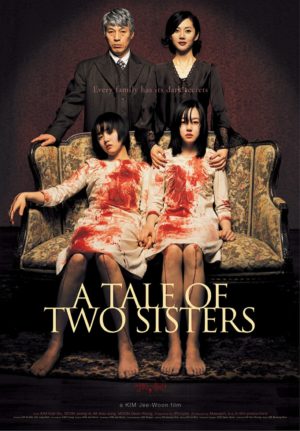 This Korean film is among the most visually expressive ghost stories you’ll ever experience—and also among the most convoluted and confusing.
This Korean film is among the most visually expressive ghost stories you’ll ever experience—and also among the most convoluted and confusing.
Kim Jee-woon is one of South Korea’s top filmmakers, having debuted with THE QUIET FAMILY in 1998 (the basis for Takashi Miike’s THE HAPPINESS OF THE KATAKURIS), and continued with the equally esteemed FOUL KING (2000) and the film festival sensation THE GOOD, THE BAD, THE WEIRD (2008). 2003’s A TALE OF TWO SISTERS (JANGHWA, HONGRYEON) is Kim Jee-woon’s most successful film by far, and the only one to garner any kind of significant release in the West. It’s become one of the most acclaimed K-horror films of recent years, and was remade by Hollywood in 2009. I’m apparently the only person who’s not over the moon about the film; I like and admire it, certainly, but…
It’s become one of the most acclaimed K-horror films of recent years, and was remade by Hollywood in 2009.
Young Su-mi and her little sister Su-yeon move into their father’s country house. Unfortunately the place is also inhabited by the girls’ mean stepmother Eun-ju–and at least one unquiet spirit!
At first Eun-ju seems overly cordial toward the girls. However, she reveals her true colors when she begins tormenting Su-yeon, against whom she bears an evident grudge. Eun-ju also acts plenty weird, watching staticy TV screens and freaking out a nice couple who come to the house to have dinner.
Eventually Eun-ju’s torment of Su-yeon grows downright monstrous. Su-mi confronts her father with this fact; he reacts by telling her that Eun-ju has been dead for several years!
Another surprise is in store for Su-mi (and the viewer) when Eun-ju begins tormenting her…until the latter is confronted by Eun-ju in an entirely different outfit and attitude. What’s real and what isn’t??

This film has a simple enough premise reminiscent of past films like THE OTHER and FIGHT CLUB, but it’s as complex and multi-layered in its execution as nearly anything you can think of. Sorting out who’s dead and who isn’t becomes quite a chore, as does discerning what’s real and what’s not, or even who it is we’re watching. Sudden viewpoint shifts are common, as are unexplained flash-forwards. By the end it’s made clear, courtesy of several convoluted flashbacks, that no less than three central characters—or at least certain facets of those characters—are actually a single person, and that the facts of the narrative are quite different from what we’ve been shown. A DVD extra has a psychiatrist weighing in on the psychological complexities of the film, and I believe you’ll have to be a psychiatrist to fully sort out what happens.
Where A TALE OF TWO SISTERS works best is as a purely visual and atmospheric spectacle. The cinematography by Lee Mogae has a seductively dark shimmer, shunning brightness or excessive contrast. The visuals complement the spare, quiet aura of the film, which contains very few conventional scares. The coiled, muted atmosphere put me in mind of a held breath, or possibly a stifled scream; given the content, I’d say both metaphors are entirely appropriate.
Vital Statistics
A TALE OF TWO SISTERS
iPictures
Director: Kim Jee-woon
Producer: Oh Ki-min
Screenplay: Kim Jee-woon
Cinematography: Lee Mogae
Editing: Ko Im-pyo
Cast: Yeom Jeong-A, Im Soo-jung, Moon Geun-young, Kim Kab-su
